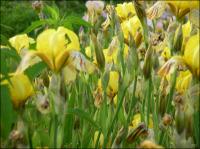Description
ARCHIVED
Note: This is a plant not currently for sale. This is an archive page preserved for informational use.
Clear yellow standards with maroon striped-dashed falls, blooms in mid-season
Clear yellow standards with maroon striped-dashed falls
ARCHIVED
Note: This is a plant not currently for sale. This is an archive page preserved for informational use.
Clear yellow standards with maroon striped-dashed falls, blooms in mid-season
ARCHIVED
Note: This is a plant not currently for sale. This is an archive page preserved for informational use.
Cobalt blue flower clusters with contrasting, showy red stems and calyces in late summer and fall. Foliage turns crimson in fall – excellent groundcover. One of the most award winning plants.
Size: 9-12” x 18”
Care: Sun to part shade in moist well-drained soil
Native: China
Awards: Five (5) of them! Georgia Gold Medal 2006, Elisabeth Carey Miller Botanical Garden Great Plant Picks, Missouri Botanical Garden Plant of Merit, Royal Horticultural Society Award of Garden Merit, Oklahoma Proven
Plumbago is Latin meaning “lead” derived from use of the plant to treat lead poisoning. First collected by Russian botanist Alexander von Bunge in 1830 in Mongolia, then introduced by Robert Fortune who found it growing in Shanghi in 1846. “Bear a profusion of brilliant cobalt blue flowers (when) the leaves take on a distinct reddish tinge.” H.H. Thomas 1915.
ARCHIVED
Note: This is a plant not currently for sale. This is an archive page preserved for informational use.
Rosette of thick silver-grey leaves with an inch-long terminal tip of each spine and offshoots, knowns as “pups” emerge near the base, even of young plants. Flowers only once & takes +10 years. In Z 5-6 plant in spring to get established.
Size: 18” x 18-28”
Care: sun in well-drained soil. We grow this in Z 5A on the south-facing side of a mound of well-drained soil, with a few large rocks nearby and gravel mulch.
Native: mountains of Arizona and New Mexico.
First Americans in the SW traded baked leaves and buds hundreds of years ago. Roasted stalks,baked buds & water mixed & fermented make pulque, further distilled to make mescal or tequila.
ARCHIVED
Note: This is a plant not currently for sale. This is an archive page preserved for informational use.
Sunshine colored saucers with orange centers in early summer
Size: 24” x 24”
Care: sun in well-drained soil
Native: Nepal, China, Pakistan & Afghanastan
Potentilla is Latin meaning powerful referring to medicinal properties. Argyrophylla means silver leaved. Potentillas used by dentists in the 16th century to reduce pain according to Gerard, English herbalist. Per Culpepper, 17th century English herbalist potentilla is to be used if Jupiter is ascending and the moon is “applying to him.” This species collected by 1831.
ARCHIVED
Note: This is a plant not currently for sale. This is an archive page preserved for informational use.
Pale pink “pussy-toe”, resembling the pads of a kitten’s foot, flowers in early summer, great silvery-gray foliage, good groundcover and rock garden plant.
Size: 2” x 18”
Care: full sun in well-drained soil, drought tolerant
Native: Temperate areas worldwide
Antennaria from the Latin antenna originally referring to the mast of a sailboat. Part of the flower supposedly resembles a butterfly’s antennae. Historically used for medicine as an astringent, a cough remedy and to break fever. First described by German physician and botanical author Leonhard Fuchs (1501-1566). Gertrude Jekyll (1848-1931), mother of the mixed perennial border, planted this in her own rock garden at Munstead Wood and in the Sundial Garden at Pednor House in Buckinghamshire. The pink version, A. dioica rosea, collected in the Rocky Mountains by C.C. Parry before 1860.

